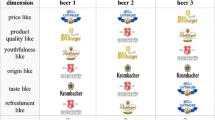Abstract
Empirical data is used to follow the maturation and change an evoked set exhibits as the decision-maker proceeds to a final choice. Results indicate that after an evoked set has been established, a subject is more likely to include newly found brands in his evoked set versus previously rejected brands even though additional positive information had been received for the previously rejected brands.
Similar content being viewed by others
References
Bettman, James R. and Jacob Jacoby. 1976. “Patterns of Processing in Consumer Information Acquisition.” InAdvances in Consumer Research. Ed. B. B. Anderson. vol. 3. Cincinnati, Ohio. Association for Consumer Research, 315–20.
Bishop, Yvonne M. M., Stephen E. Fienberg, and Paul W. Holland. 1975.Discrete Multivariate Analysis: Theory and Practice. Cambridge, Massachusetts: The MIT Press.
Clarkson, Geoffrey P. 1962.Portfolio Selection: A Simulation of Trust Investment. Dissertation. Ford Foundation, Englewood Cliffs, New Jersey: Prentice-Hall, Inc.
Cyert, Richard M. and James G. March. 1963.A Behavioral Theory of the Firm. Englewood Cliffs, New Jersey: Prentice-Hall, Inc.
Friedman, Monroe. 1977. “Consumer Use of Informational Aids in Supermarkets.”Journal of Consumer Affairs 11.1 (Summer) 78–79.
Jacoby, Jacob. 1974. “Consumer Reaction to Information Displays: Packaging and Advertising.” InAdvertising and the Public Interest. Ed. S. F. Divita. Chicago: American Marketing Association.
—, Robert W. Chestnut, Karl C. Weigl, and William A. Fisher. 1976. “Pre-Purchase Information Acquisition: Description of a Process Methodology, Research Paradigm, and Pilot Investigation.” InAdvances in Consumer Research. Ed. B. B. Anderson. vol. 3. Cincinnati, Ohio., Association for Consumer Research, 306–14.
—, Donald E. Speller, and Carol A. Kohn. 1974. “Brand Choice Behavior as a Function of Information Load.”Journal of Marketing Research 11 (February): 63–9.
—, George J. Szybillo, and Jacqueline Busato-Schach. 1977. “Information Acquisition Behavior in Brand Choice Situations,”Journal of Consumer Research 3 (March). 209–16.
Kohn-Berning, Carol A. and Jacob Jacoby. 1974. “Patterns of Information Acquisition in New Product Purchases.”Journal of Consumer Research 1 (September). 18–22.
Lussier, Denis A. and Richard W. Olshavsky. 1979. “Task Complexity and Contingent Processing in Brand Choice.”Journal of Consumer Research 6 (September): 154–65.
Park, C. Whan. 1978. “A Conflict Resolution Choice Model.”Journal of Consumer Research 5 (September), 124–37.
Payne, John W. 1976. “Task Complexity and Contingent Processing in Decision Making: An Information Search and Protocol Analysis.”Organizational Behavior and Human Performance 16.2 (August): 366–87.
Winer, J. B. 1971.Statistical Principles in Experimental Design. Second Edition. New York. McGraw-Hill Book Company, 399–400.
Wright, Peter. 1975. “Consumer Choice Strategies: Simplifying Vs. Optimizing.”Journal of Marketing Research 12 (February): 60–7.
— and Fredrick Barbour. 1977. “Phased Decision Strategies. Sequels to an Initial Screening.” InStudies in Management Science. Multiple Criteria Decision-Making. Eds. M. K. Starr and M. Zeleny. New York: North-Holland, 91–110.
Author information
Authors and Affiliations
Rights and permissions
About this article
Cite this article
Sutton, R.J. Using empirical data to investigate the likelihood of brands being admitted or readmitted into an established evoked set. JAMS 15, 82–89 (1987). https://doi.org/10.1007/BF02722174
Issue Date:
DOI: https://doi.org/10.1007/BF02722174




